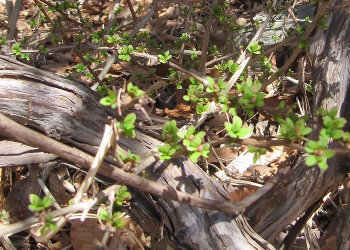
Think of them as bait-and-switch artists. They're among the first to leaf out in the shade of backyards, street edges, town parks, and forests.
But take a closer look.
The aggressive, invasive, thorny barberry is an escapee from backyard horticulture. It is on the state's invasive plant list, yet still sold in garden centers. There are actually two species of barberry, Japanese (Berberis thunbergii) and European (Berberis vulgaris)
Unfortunately, the plant is tick bait. Three Connecticut researchers determined a few years ago that where barberry flourishes, tick populations flourish, too. (See report on ticks and barberry.)
As if barberry weren't enough, thorny, multiflora rose stems take on an electric green hue in March. Invasive Japanese honeysuckle begins its smothering climb over the spring landscape.
If these or other invasive plants are spoiling your home or community landscape, here’s the good news: They are very visible during March and early April. According to David Gumbart, retired director of land management for The Nature Conservancy in Connecticut, cut the stems as close as possible to the ground after the first flush of leaves. It is more effective than cutting it later in the growing season.
“I don’t know exactly how many times you have to cut Japanese barberry before the plant dies,” says Gumbart. “But every time we go back after cutting, we see smaller, weaker shrubs.” He says the mortality rate depends on local conditions and the maturity of the plant.
To learn more about this seasonal advantage, visit "Beware the First Leaves of Spring" at Zip06.com.
To learn more about invasive weeds and how to control them, visit these websites:
Connecticut Invasive Plant Working Group: www.CIPWG.UConn.edu
Cornell Weed Identification, includes pictures of seedlings: https://blogs.cornell.edu/weedid/
Invasive Plant Atlas of New England: http://www.eddmaps.org/ipane/ Extensive information regarding individual invasive species, their biology, and eradication.
